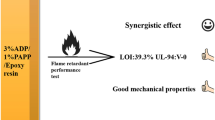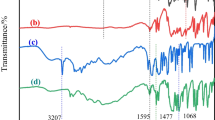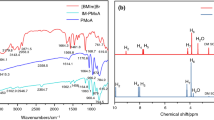Abstract
In the field of electronic and electrical applications, it has always been a challenge to synchronously improve the flame-retardant and smoke-suppression properties for epoxy resins. In this research, a novel flame-retardant phosphonic acid piperazine salt (PTPAP) was successfully synthesized in an environmentally friendly manner and used to fabricate flame-retardant EP thermosets. The fire safety and flame-retardant mechanisms of EP/PTPAP thermosets were detailedly studied. When merely 6 wt% PTPAP was introduced into EP substrate, the EP/PTPAP thermosets gained UL-94V-0 grade and their LOI value improved from 21.3% of pure EP to 28.3% with the increase of 32.9%. The introduction of PTPAP promoted the premature degradation and charring of EP matrix, and the intumescent, compact, and sealed char layer was produced on the surface of EP/PTPAP thermosets during combustion. Besides, PTPAP decomposed and produced the PO· and inert gases, which efficaciously exerted the free radical trapping and dilution effect in vapor phase. Therefore, the emission of smoke and heat was distinctly constrained and the EP/PTPAP thermosets was endowed with the superior fire safety. This flame-retardant EP/PTPAP thermosets showed broad application prospects under the environment of sustainable development because of the eco-friendly and simplicity of the synthesis of PTPAP.
Graphical abstract










Similar content being viewed by others
References
Yu B, Shi Y, Yuan B, Qiu S, Song L, Hu Y (2015) Enhanced thermal and flame retardant properties of flame-retardant-wrapped graphene/epoxy resin nanocomposites. J Mater Chem A 3:8034–8044
Chen M, Lin X, Liu C (2021) An effective strategy to enhance the flame retardancy and mechanical properties of epoxy resin by using hyperbranched flame retardant. J Mater Sci 56:5956–5974
Ma C, Li J (2019) Synthesis of an organophosphorus flame retardant derived from daidzein and its application in epoxy resin. Compos Part B-Eng 178:107471
Chen R, Luo Z, Yu X (2020) Synthesis of chitosan-based flame retardant and its fire resistance in epoxy resin. Carbohydr Polym 245:116530
Xie W, Huang S, Liu S (2020) Phosphorus-based triazine compound endowing epoxy thermosets with excellent flame retardancy and enhanced mechanical stiffness. Polym Degrad Stabil 180:109293
Zhang S, Sun J, Xu B, Li H, Gu X (2021) Preparation of flame retardant and conductive epoxy resin composites by incorporating functionalized multi-walled carbon nanotubes and graphite sheets. Poly Advan Technol 32:2093–2101
Zhang J, Li Z, Wang D (2021) Construction of a novel three-in-one biomass based intumescent fire retardant through phosphorus functionalized metal-organic framework and β-cyclodextrin hybrids in achieving fire safe epoxy. Compos Commun 23:100594
Zhu Z, Lin P, Wang H, Yu B (2020) A facile one-step synthesis of highly efficient melamine salt reactive flame retardant for epoxy resin. J Mater Sci 55:12836–12847. https://doi.org/10.1007/s10853-020-04935-6
Duan H, Cao J, Chen Y (2020) A phosphorus/boron-containing triazine-trione derivative endowing epoxy resin with excellent flame retardance. Express Polym Lett 14:908–923
Chen Y, Duan HJS (2020) Novel phosphorus/nitrogen/boron-containing carboxylic acid as co-curing agent for fire safety of epoxy resin with enhanced mechanical properties. J Hazard Mater 402:123769
Wei Z, Sun H, Yu Q, Zhang S, Wang Z (2020) Effect of ethyl-bridged diphenylphosphine oxide on flame retardancy and thermal properties of epoxy resin. Polym Advan Technol 31:1426–1436
Zhou L, Zhang G, Feng Y (2018) Design of a self-healing and flame-retardant cyclotriphosphazene-based epoxy vitrimer. J Mater Sci 53:7030–7047. https://doi.org/10.1007/s10853-018-2015-z
Alongi J, Blasio A, Milnes J, Malucelli G, Bourbigot S, Kandola B, Camino G (2015) Thermal degradation of DNA, an all-in-one natural intumescent flame retardant. Polym Degrad Stabil 113:110–118
Chi Z, Guo Z, Xu Z (2020) A DOPO-based phosphorus-nitrogen flame retardant bio-based epoxy resin from diphenolic acid: synthesis, flame-retardant behavior and mechanism. Polym Degrad Stabil 176:109151
Xu B, Wu X, Ma W, Qiu Y (2018) Synthesis and characterization of a novel organic-inorganic hybrid char-forming agent and its flame-retardant application in polypropylene composites. J Anal Appl Pyrol 134:231–242
Xu Z, Jia H, Yan L (2021) Synergistic effects of organically modified montmorillonite in combination with metal oxides on the fire safety enhancement of intumescent flame-retarded epoxy resins. J Vinyl Addit Techn 27:161–173
Zhao C, Luo Z, Li D (2021) Excellent role of Cu2O on fire safety of epoxy resin with ammonium polyphosphate based on the construction of self-intumescent flame retardant system. J Appl Polym Sci 138:e50503
Xie W, Huang S, Tang D (2020) Synthesis of a furfural-based DOPO-containing co-curing agent for fire-safe epoxy resins. RSC Adv 10:1956–1965
Hamciuc C, Serbezeanu D, Carja ID (2013) Effect of DOPO units and of polydimethylsiloxane segments on the properties of epoxy resins. J Mater Sci 48:8520–8529. https://doi.org/10.1007/s10853-013-7670-5
Fang M, Qian J, Shi Y (2021) Synthesis of a novel flame retardant containing phosphorus, nitrogen, and silicon and its application in epoxy resin. ACS Omega 6:7094–7105
Zhang Q, Wang J, Yang S (2020) Synthesis of a P/N/S-based flame retardant and its flame retardant effect on epoxy resin. Fire Saf J 113:102994
Shao Z, Tang Z, Lin Z (2020) Phosphorus/sulfur-containing aliphatic polyamide curing agent endowing epoxy resin with well-balanced flame safety, transparency and refractive index. Mater Des 187:108417
Yu H, Xia Y, Xu X (2020) Preparation of organic–inorganic intumescent flame retardant with phosphorus, nitrogen and silicon and its flame retardant effect for epoxy resin. J Appl Polym Sci 137:49256
Liu L, Xu Y, Li S, Xu M, Li B (2019) A novel strategy for simultaneously improving the fire safety, water resistance and compatibility of thermoplastic polyurethane composites through the construction of biomimetic hydrophobic structure of intumescent flame retardant synergistic system. Compos Part B-Eng 176:107218
Xu M, Xia S, Liu C (2018) Preparation of poly(phosphoric acid piperazine) and its application as an effective flame retardant for epoxy resin. Chin J Polym Sci 36:1–10
Xiao F, Wu K, Luo F (2017) An efficient phosphonate-based ionic liquid on flame retardancy and mechanical property of epoxy resin. J Mater Sci 52:13992–14003. https://doi.org/10.1007/s10853-017-1483-x
Liu L, Xu Y, Pan Y, Xu M, Li B (2020) Facile synthesis of an efficient phosphoramide flame retardant for synchronous enhancement of fire safety and crystallization rate of biodegradable poly (lactic acid). Chem Eng J 421:127761
Liu B, Gao X, Zhao Y (2017) Prospect of 9,10-dihydro-9-oxa-10-phosphaphenanthrene 10-oxide-based oligosiloxane in the preparation of high damping methyl phenyl vinyl silicone rubbers with broad temperature range. J Mater Sci 52:13307–13317. https://doi.org/10.1007/s10853-017-1085-7
Ma W, Xu B, Shao L, Qian L (2019) Synthesis of (1,4-methylenephenylphosphinic acid) piperazine and its application as a flame retardant in epoxy thermosets. Macromol Mater Eng 304:1900419
Zhu Z, Wang L, Lin X (2020) Synthesis of a novel phosphorus-nitrogen flame retardant and its application in epoxy resin. Polym Degrad Stabil 169:108981
Liu L, Xu Y, Xu M, Li B (2019) Economical and facile synthesis of a highly efficient flame retardant for simultaneous improvement of fire retardancy, smoke suppression and moisture resistance of epoxy resins. Compos Part B-Eng 167:422–433
Federico C, Lorenza M, Julio G, Guido S, Alberto F (2018) Graphene oxide exoskeleton to produce self-extinguishing, nonignitable, and flame resistant flexible foams: A mechanically tough alternative to inorganic aerogels. Adv Mater Interfaces 5:1801288
Yan L, Xu Z, Wang X, Deng N (2018) Preparation of a novel mono-component intumescent flame retardant for enhancing the flame retardancy and smoke suppression properties of epoxy resin. J Thermal Anal Calorim 134:1505–1519
Liu L, Xu Y, Xu M, Li B (2021) An efficient synergistic system for simultaneously enhancing the fire retardancy, moisture resistance and electrical insulation performance of unsaturated polyester resins. Mater Des 187:108302
Jin X, Gu X, Chen C (2017) The fire performance of polylactic acid containing a novel intumescent flame retardant and intercalated layered double hydroxides. J Mater Sci 52:12235–12250. https://doi.org/10.1007/s10853-017-1354-5
Guo W, Nie S, Kalali E (2019) Construction of SiO2@UiO-66 core-shell microarchitectures through covalent linkage as flame retardant and smoke suppressant for epoxy resins. Compos Part B-Eng 176:107261
Jian R, Wang P, Xia L (2017) Low-flammability epoxy resins with improved mechanical properties using a Lewis base based on phosphaphenanthrene and 2-aminothiazole. J Mater Sci 52:9907–9921. https://doi.org/10.1007/s10853-017-1102-x
Acknowledgements
Dr Lubin Liu and Dr Yue Xu equally contributed to this work and were listed as co-first author. This work was financially supported by the Open Project Program of Engineering Laboratory of Non-halogen Flame Retardants for Polymers, Beijing Technology and Business University, China (No. BTBUFR20-6) and Natural Science Foundation of China (Nos. 51673035 and 51773031).
Author information
Authors and Affiliations
Corresponding authors
Additional information
Handling Editor: Jaime Grunlan.
Publisher's Note
Springer Nature remains neutral with regard to jurisdictional claims in published maps and institutional affiliations.
Supplementary Information
Below is the link to the electronic supplementary material.
Rights and permissions
About this article
Cite this article
Xu, Y., Liu, L., Yan, C. et al. Eco-friendly phosphonic acid piperazine salt toward high-efficiency smoke suppression and flame retardancy for epoxy resins. J Mater Sci 56, 16999–17010 (2021). https://doi.org/10.1007/s10853-021-06384-1
Received:
Accepted:
Published:
Issue Date:
DOI: https://doi.org/10.1007/s10853-021-06384-1




